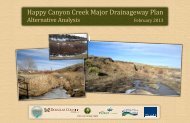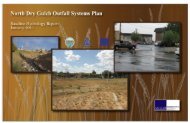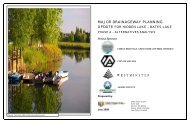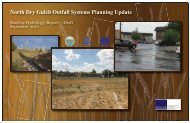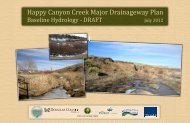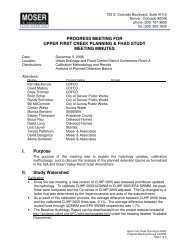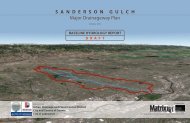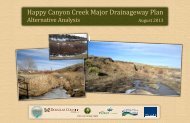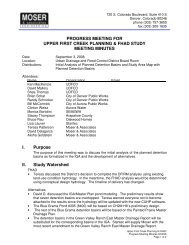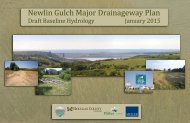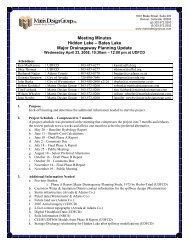Final Baseline Hydrology Report - October 2012 - Urban Drainage ...
Final Baseline Hydrology Report - October 2012 - Urban Drainage ...
Final Baseline Hydrology Report - October 2012 - Urban Drainage ...
You also want an ePaper? Increase the reach of your titles
YUMPU automatically turns print PDFs into web optimized ePapers that Google loves.
DRAINAGE CRITERIA MANUAL (V. 1)<br />
RUNOFF<br />
RUNOFF DRAINAGE CRITERIA MANUAL (V. 1)<br />
in Figure RO-A6 in Appendix A at the end of this chapter.<br />
3.2.2 Depression Losses<br />
Rainwater that is collected and held in small depressions and does not become part of the general<br />
surface runoff is called depression loss. Most of this water eventually infiltrates or is evaporated.<br />
Depression losses also include water intercepted by trees, bushes, other vegetation, and all other<br />
surfaces. The CUHP method requires numerical values of depression loss as inputs to calculate the<br />
effective rainfall. Table RO-6 can be used as a guide in estimating the amount of depression (retention)<br />
losses to be used with CUHP.<br />
Figure RO-5—Watershed Imperviousness, Single-Family Residential Two-Story Houses<br />
Table RO-6—Typical Depression Losses for Various Land Covers<br />
(All Values in Inches. For use with the CUHP Method)<br />
Land Cover Range in Depression (Retention) Losses Recommended<br />
Impervious:<br />
Large paved areas 0.05 - 0.15 0.1<br />
Roofs-flat 0.1 - 0.3 0.1<br />
Roofs-sloped 0.05 - 0.1 0.05<br />
Pervious:<br />
Lawn grass 0.2 - 0.5 0.35<br />
Wooded areas and open fields 0.2 - 0.6 0.4<br />
When an area is analyzed for depression losses, the pervious and impervious loss values for all parts of<br />
the watershed must be considered and accumulated in proportion to the percent of aerial coverage for<br />
each type of surface.<br />
3.2.3 Infiltration<br />
The flow of water into the soil surface is called infiltration. In urban hydrology much of the infiltration<br />
occurs on areas covered with grass. <strong>Urban</strong>ization can increase or decrease the total amount of<br />
infiltration.<br />
Soil type is the most important factor in determining the infiltration rate. When the soil has a large<br />
percentage of well-graded fines, the infiltration rate is low. In some cases of extremely tight soil, there<br />
may be, from a practical standpoint, essentially no infiltration. If the soil has several layers or horizons,<br />
the least permeable layer near the surface will control the maximum infiltration rate. The soil cover also<br />
plays an important role in determining the infiltration rate. Vegetation, lawn grass in particular, tends to<br />
increase infiltration by loosening the soil near the surface. Other factors affecting infiltration rates include<br />
slope of land, temperature, quality of water, age of lawn and soil compaction.<br />
Figure RO-6—Runoff Coefficient, C, vs. Watershed Percentage Imperviousness NRCS Hydrologic<br />
Soil Group A<br />
As rainfall continues, the infiltration rate decreases. When rainfall occurs on an area that has little<br />
antecedent moisture and the ground is dry, the infiltration rate is much higher than it is with high<br />
2007-01 RO-17<br />
<strong>Urban</strong> <strong>Drainage</strong> and Flood Control District<br />
RO-20 2007-01<br />
<strong>Urban</strong> <strong>Drainage</strong> and Flood Control District



